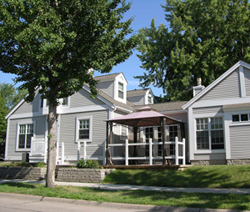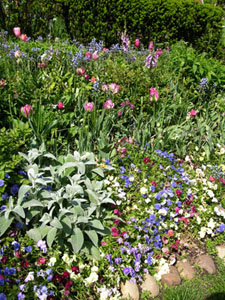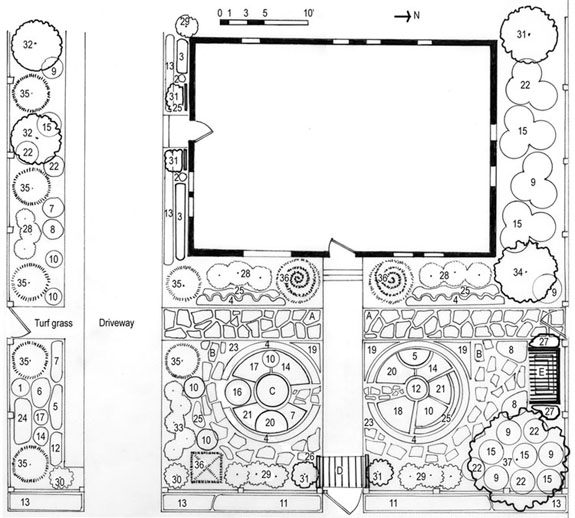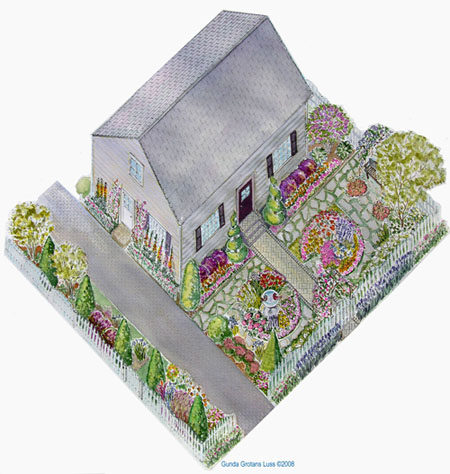Cape Cod Revival 1930-1955
 | Fig. 56 |
The Cape Cod revival begun in 1932 by Boston architect Royal Barry Wills, becomes after WWII, "the most popular home design ever known" (Schuler, 1988). Homes are small, and usually have no front porch, but by the 50s include a screened breezeway connecting the house to the garage (Fig. 56 also has a side patio). Builders appeal to a broad market by painting homes uniformly beige.
The Minimal Garden plan for a Cape Cod home
In the 30s most gardens are formal, with lawn and neatly pruned evergreens. This style changes little during WWII and by the mid 50s “many Americans in the post Korean War building boom, believe that elegant gardens are a luxury or indulgence” (Tischler, 1989). Instead, peacetime is used as an opportunity to return to family activities. With old utilitarian functions moved inside or eliminated, the back and side yards become extensions of the in-doors, accommodating children’s sandboxes, patios, and barbecue grills. While homeowners of these modest homes may choose their garden style from several options, including the cottage garden, the most common choice is still the manicured lawn with minimal evergreen foundation plants and carefully mounded shrubbery. The strategically placed foundation plantings tie the house to the ground plane, ‘soften’ corners, and screen the foundation. The front yard is simply a setting for the house. Fences and hedges in this minimal landscape are not used, with the lawn from one neighbor merging with the next.
The “Cottage” Garden plan for a Cape Cod home
 | Fig. 57 |
The most successful cottage gardens are a mix of traditional and new plants organized for constant bloom and texture. The front and back yard is densely planted, with the path to the front door passing through a rose covered arbor set in a picket fence. This path is bordered by rows of double daisies, followed by a tangled mass of bluebells, primrose, bachelor buttons, self-sown annuals, a row of crown imperials, and leads to a climber-clad porch (Phillips, 1990). Edges of the yard are either lined with flowerbeds, (with taller plants in the back, supported by a white picket fence), or shrubs.
Paths can change in a cottage garden to define cameo areas of interest. Path materials vary from lawn to gravel to flagstone and weathered brick, while flowerbeds are edged with large pebbles or shells.
Water features may include fishponds, a rustic fountain, or simulated stream.
 | Fig. 58 |
Traditional cottage flowers are: Lady’s mantle, columbine, primula, creeping buttercup, catmint, chamomile, clematis, crown imperial, daisy, foxglove, fuchsia, ribbon grass, hardy geranium, hellebore, hollyhock, iris, lily, loosestrife, lungwort, lupine, narcissus, nasturtium, pansy, peony, sweet pea, dianthus, poppy, primrose, salvia, houseleek (hens and chickens), snowdrop, violet, wallflowers, and wisteria (Phillips, 1990).
Garden décor can include small statuary, a birdhouse or feeder, large clay pottery, garden furniture, and rustic low walls. Height can be added by the use of rustic poles made of willow, poplar, or hazel arches to support hops, clematis, honeysuckle or rose.
Hedges and topiary
Hedges are informal and from a variety of plant materials including hawthorn, or mixture of shrubs and perennials such as peonies, yew, box, wild rose, viburnum, or elderberry . Shapes play an important part in the Cottage garden and could include topiary trained from yews or pollarded willows. Trained yew or box trees can be purchased in pyramid, sphere, spiral, or lozenge shapes.
 | Fig. 59 |
Shrubs
The most common front and side yard shrubs are flowering hydrangea, forsythia, and bridal wreath spirea with a yew or buckthorn hedge bordering the lawn.
The ‘Cottage Garden’ is a charming, historically appropriate, and may be a wise ecological landscaping option for this style home.
 | Fig. 60 |
Plant List for Cottage garden 1930-
Fig.61| Scientific Name | Common Name | Height | Width | Texture | Seasonal interest |
| Annuals | |||||
| 1.Canna indica | Canna lily | 48"-60" | 30" | Coarse | Summer |
| 2. Ipomoea purpurea | Morning glory vine | 120" | 24" | Medium | Summer |
| Biennials | |||||
| 3. Alcea rosea | Hollyhock | 24"-96" | 18" | Coarse | Summer-Fall |
| 4. Dianthus barbutus | Sweet William | 18" | 6" | Medium | Late Spring |
| Perennials | |||||
| 5. Bellis perennis | English daisy | 6" | 6" | Medium | Spring |
| 6. Delphinium belladonna | Delphinium | 48" | 18" | Med.Fine | Summer |
| 7.Geranium erianthum | • Cranesbill | 24" | 24" | Medium | Summer-Fall |
| 8.Heuchera sanguinea | • Coral Bells | 12"-20" | 12" | Medium | Late Spring |
| 9. Hosta sieboldiana | Variegated Hosta | 18"-28" | 24"-36" | Coarse | Summer |
| 10. Iris germanica 'Florentina' | 'Florentina', White iris | 36" | 18" | Medium | Spring |
| 11.Lavendula angustifolia | English lavender [zone 5] | 12"-24" | 12"-24" | Fine | Summer |
| 12.Lilium martagon | Turk's cap lily | 48"-72" | 24" | Medium | Summer |
| 13. Lychnis coronaria | Rose Campion | 24" | 18" | Medium | Summer |
| 14. Monarda didyma | • Bee balm | 24"-36" | 18" | Medium | Summer |
| 15. Osmunda cinnamomea | • Cinnamon fern | 36" | 36" | Medium | Summer |
| 16. Paeonia lactiflora 'Albert Crousse' | 'Albert Crousse' Peony [White to Pink] | 30" | 30" | Medium | Early Summer |
| 17. Phalaris arundinacea | Ribbon grass [invasive] | 24"-48" | 24" | Fine | Summer |
| 18. Phlox paniculata | Summer phlox | 24"-48" | 24" | Medium | Early Fall |
| 19. Phlox subulata | Moss phlox | 4" | 8" | Fine | Spring |
| 20. Rudbeckia hirta | • Black-eyed Susan | 12"-36" | 12" | Medium | Summer |
| 21. Salvia officinalis | Garden sage [zone 5] | 18"-24" | 18" | Medium | Summer |
| 22. Smilacina racesmosa | • False Solomon's seal | 36" | 24" | Medium | Midsummer |
| 23. Thymus serpellum | Creeping thyme | 6" | 18" | Fine | Late Spring |
| 24. Tridens flavus | • Purpletop grass | 48" | 24" | Coarse | Summer-Fall |
| 25. Tulipa | Cottage tulip | 12"-30" | 6" | Medium | Late Spring |
| Vines | |||||
| 26. Clematis 'Madame Edouard Andre' | Clematis | 6'-8' | 3' | Medium | Early Summer |
| 27. Wisteria sinensis | Wisteria | 100' | 5' | Medium | Summer |
| Shrubs | |||||
| 28.Physocarpus opulifolius | Ninebark 'Diablo' | 4'-10 | 4'-10' | Medium | Summer |
| 29. Rosa rugosa 'Alba' | White rugosa rose | Summer | |||
| 30. Rosa rugosa 'Delicata' | Delicata rose | 3'-4' | 3'-4' | Coarse | Summer-Fall |
| 31. Rosa setigera | Blackberry rose [climber] | 15' | 3'-4' | Medium | Midsummer |
| 32. Sambucus canadensis | • American Elder | 10' | 10' | Medium | Spring-Fall |
| 33. Spiraea japonica | Japanese white spirea | 4'-5' | 4'-5' | Med.Fine | Summer |
| 34. Syringa microphylla | Littleleaf lilac | 6' | 9'-12' | Med.Fine | Late Spring |
| 35. Thuja occidentalis* | • Arborvitae | 30'* | 5' | Med.Fine | Evergreen |
| 36. Taxus canadensis | • Yew [topiary] | 3'-6' | 6'-8' | Medium | Evergreen |
| Trees | |||||
| 37. Staphylea trifolia | • Bladdernut | 10'-15' | 8'-10' | Medium | Spring-Fall |
Cottage Garden, illustrated
 | Fig. 62 |
* Minimize pruning by selecting a cultivar that grows only to 8’.
Main Features of a Cottage Garden:
• Mix of traditional and new plants for constant bloom, densely planted
• Topiary
• Mixed plantings of evergreens and deciduous shrubs
• Brick and flagstone paths
• Picket fence
• Rose covered arbor over gate
• Wisteria arbor over bench
• Water feature such as birdbath, fishpond, or rustic fountain
• Statuary, birdhouse, garden furniture, clay pottery
• Habitat for beneficial insects, birds, and butterflies
